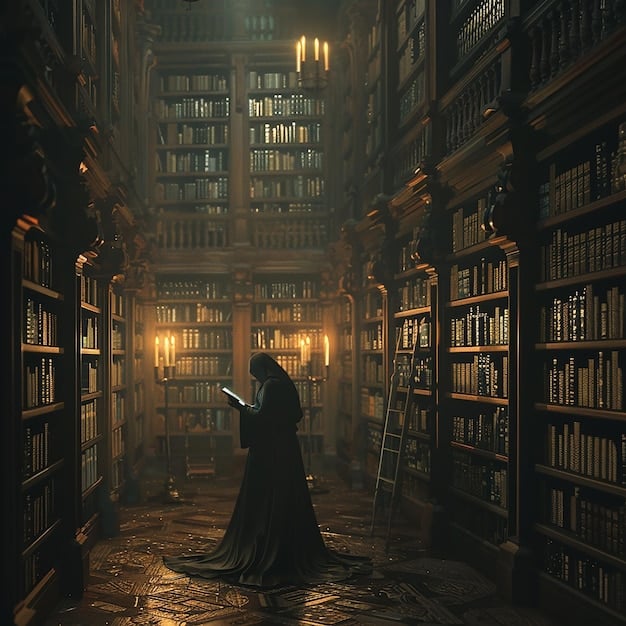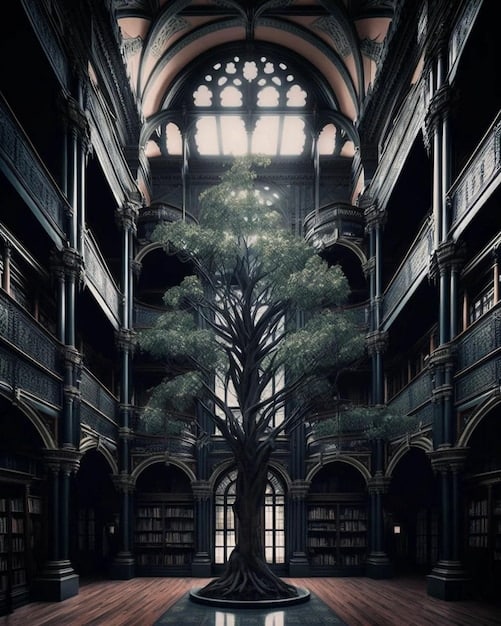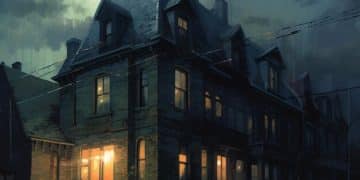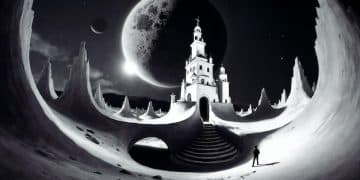Decoding Dark Academia: Key Tropes and Themes Explored

Decoding Dark Academia: Identifying the Key Tropes and Themes That Define the Genre involves understanding its romanticization of classical education, gothic aesthetics, and morally ambiguous characters, offering insight into its enduring appeal and cultural impact.
Dark Academia has emerged as a captivating aesthetic and subculture, drawing in countless individuals with its unique blend of classic literature, gothic architecture, and a hint of rebellion. But what exactly defines this genre? Decoding Dark Academia: Identifying the Key Tropes and Themes That Define the Genre requires a closer look at its core elements and cultural influences.
Let’s delve into the depths of Dark Academia, exploring its defining characteristics and unraveling the mysteries that make it so alluring. What are the recurring themes and elements that constitute Dark Academia?
Decoding Dark Academia: Identifying the Key Tropes and Themes That Define the Genre
Decoding Dark Academia: Identifying the Key Tropes and Themes That Define the Genre requires understanding the nuances that set it apart. It is not merely an aesthetic but a complex blend of literature, fashion, and lifestyle choices. Let’s explore the key elements that form this intriguing subculture.
The Allure of Classical Literature and Education
One of the defining features of Dark Academia is its deep appreciation for classical literature and a romanticized view of higher education. This often includes:
- An emphasis on reading classic works of literature like those by Shakespeare, Oscar Wilde, and Edgar Allan Poe.
- A focus on academic subjects such as Latin, Greek, philosophy, and history.
- An idealized vision of learning and intellectual pursuits.
Gothic and Collegiate Architecture
Dark Academia is visually striking, with a distinct preference for gothic and collegiate architecture. This includes:
- Old universities and libraries with imposing stone buildings and arched windows.
- Dimly lit interiors with rich, dark wood and vintage décor.
- Settings that evoke a sense of timelessness and intellectual pursuit.

Fashion and Style
The fashion associated with Dark Academia plays a significant role in its overall appeal. Key elements include:
- Dark, muted colors like browns, blacks, and burgundies.
- Tweed blazers, argyle sweaters, and plaid skirts or trousers.
- Vintage accessories such as antique jewelry, leather satchels, and fountain pens.
In summary, decoding Dark Academia: Identifying the Key Tropes and Themes That Define the Genre shows a blend of intellectual romanticism, gothic aesthetics, and a profound appreciation for the past form the essence of the Dark Academia subculture. These elements combine to create a world that fascinates and provides a unique escape from the mundane.
The Morally Grey Characters and Existential Themes in Decoding Dark Academia
Decoding Dark Academia also often explores morally ambiguous characters and profound existential themes. These elements add depth and complexity to the genre. Let’s consider these:
The Morally Grey Character
Characters in Dark Academia settings are rarely purely good or evil. They often grapple with complex moral dilemmas, making them more relatable and intriguing. This includes:
- Characters who make questionable choices in pursuit of knowledge or personal gain.
- Exploration of the darker aspects of human nature.
- A focus on the consequences of one’s actions.
Existential Themes and Dilemmas
Dark Academia often delves into profound questions about life, death, and the human condition. These existential themes often involve:
- Exploration of mortality and the fleeting nature of existence.
- A preoccupation with the meaning of life and the search for purpose.
- Themes of isolation and alienation.

The Romanticization of the Past
This ties into another aspect, the romanticization of the past, which is inherent in the Dark Academia genre. This includes:
- A nostalgic longing for a bygone era, often the 19th or early 20th century.
- An idealized view of history and classical culture.
- A fascination with vintage aesthetics and historical settings.
Ultimately, the morally grey characters and existential themes within Dark Academia provide a deeper engagement with the narrative, provoking thought and introspection, making it more than just a superficial aesthetic. This is key to understanding the genre’s appeal.
Cultural Influences Shaping the Dark Academia Genre
Understanding the cultural influences that have shaped is essential for decoding Dark Academia: Identifying the Key Tropes and Themes That Define the Genre. Various literary, cinematic, and historical sources have contributed to its development.
Literary Inspirations
Numerous works of literature have laid the foundation for Dark Academia’s themes and aesthetics. Some key examples include:
- “The Secret History” by Donna Tartt: Often considered the quintessential Dark Academia novel, exploring themes of elitism, obsession, and moral decay.
- Works by Edgar Allan Poe: Poe’s gothic tales and exploration of the macabre resonate deeply within the genre.
- “Brideshead Revisited” by Evelyn Waugh: A novel that captures the atmosphere of privilege, intellectualism, and moral ambiguity.
Cinematic Influences
Films have also played a significant role in shaping the visual and thematic elements of Dark Academia. Notable examples include:
- “Dead Poets Society”: A film celebrated for its themes of nonconformity, the pursuit of knowledge, and the influence of classical literature.
- “The Picture of Dorian Gray”: This captures the aesthetic of decaying beauty, and the consequences of moral corruption.
- “Kill Your Darlings”: Explores themes of love, betrayal, and intellectual rebellion in a university setting.
Historical Context
The genre often draws inspiration from historical settings and events, particularly those associated with classic education and societal upheaval. These include:
- The ambiance of old European universities, such as Oxford and Cambridge.
- The aesthetic and intellectual climate of the early 20th century.
- Historical events that challenge traditional norms and values.
To sum up, numerous cultural influences, including literature, cinema, and historical contexts, have converged to create the rich tapestry of Dark Academia. By recognizing these influences, we can more comprehensively decipher its various facets.
The Internet’s Role in the Popularization of Decoding Dark Academia
The internet has played a pivotal role in the explosion of Dark Academia. Social media platforms, online communities, and digital content have facilitated its spread and accessibility. Let’s examine:
Social Media Platforms
Platforms like Tumblr, Pinterest, and Instagram have been instrumental in visualizing and disseminating the Dark Academia aesthetic. Key aspects of this include:
- Curated images and mood boards that capture the visual essence of Dark Academia.
- Hashtags and trends that allow enthusiasts to share and discover related content.
- The creation of online communities centered around Dark Academia themes.
Online Communities and Forums
Online communities and forums provide spaces for enthusiasts to discuss and explore Dark Academia in greater depth. These include:
- Dedicated forums and subreddits where members share their thoughts, recommendations, and creative works.
- Online book clubs focused on Dark Academia literature.
- Virtual study groups that explore academic subjects associated with the genre.
Digital Content and Creators
Digital content creators have also contributed significantly to the popularization of Dark Academia through various media forms. Examples include:
- YouTube channels that analyze Dark Academia themes in literature, film, and culture.
- Bloggers who chronicle their experiences with Dark Academia fashion, lifestyle, and intellectual pursuits.
- Podcasters who discuss the genre’s appeal and cultural significance.
In conclusion, if we are decoding Dark Academia: Identifying the Key Tropes and Themes That Define the Genre, we need to look towards the influence of the internet. No analysis is compete without it’s impact.
Criticisms and Misconceptions Surrounding Decoding Dark Academia
Despite its popularity, Dark Academia is not without its critics and misconceptions. Addressing these issues is essential for a balanced understanding of the genre. Commonly cited issues include:
Elitism and Exclusivity
One of the main criticisms is that Dark Academia promotes elitism and exclusivity. The key points connected with this include:
- The genre’s focus on classical education and privileged settings can alienate individuals from diverse backgrounds.
- The romanticization of academia may overlook the challenges and inequalities within educational institutions.
- It may suggest a superiority associated with intellectual pursuits, thereby marginalizing other forms of knowledge and expression.
Superficiality and Aestheticization
Some critics argue that Dark Academia can be overly focused on aesthetics, leading to superficiality. Considerations include:
- The emphasis on fashion and visual elements may overshadow the deeper intellectual and thematic aspects of the genre.
- It can devolve into merely a trend, devoid of substantive engagement with literature, philosophy, or history.
- The focus on curated images and idealized settings may create unrealistic expectations.
Potential for Harmful Romanticization
There are concerns about the potential for harmful romanticization of certain themes. These include:
- The romanticization of depression, social isolation, and mental health issues. This aspect needs careful discourse around it.
- Misrepresentation of issues of inequality.
- The romanticization of self destruction and destructive habits.
To summarize, while Dark Academia has gained a significant following, it is vital to address criticisms regarding elitism, superficiality, and potential harm. A balanced perspective allows for a more informed appreciation of the genre’s strengths and limitations.
| Key Point | Brief Description |
|---|---|
| 📚 Classical Literature | Appreciation for classic works like Shakespeare & Poe. |
| 🏛️ Gothic Architecture | Settings in old universities and dimly lit libraries. |
| 💀 Existential Themes | Exploration of mortality and the meaning of life. |
Frequently Asked Questions About Dark Academia
Dark Academia is characterized by a love for classical literature, gothic architecture, vintage fashion, and themes of intellectualism and existentialism. Decoding Dark Academia involves uncovering these elements to understand its appeal.
Essential readings include “The Secret History” by Donna Tartt, works by Edgar Allan Poe, and “Brideshead Revisited” by Evelyn Waugh. These books explore themes and aesthetics central to Dark Academia.
The internet, particularly social media platforms, has played a massive role by visualizing the aesthetic, creating online communities, and disseminating Dark Academia through digital content and online forums.
Common criticisms include concerns about elitism, superficiality, and the potential for harmful romanticization of certain themes such as depression and self-destructive behaviors.
Yes, if it leads to the harmful romanticization of mental health issues, elitism, or the reinforcement of unrealistic expectations. A balanced perspective is necessary when engaging with the genre.
Conclusion
In conclusion, decoding Dark Academia: Identifying the Key Tropes and Themes That Define the Genre reveals a rich tapestry of literary, aesthetic, and cultural influences. Its combination of classical education, gothic aesthetics, and morally complex characters continues to draw in many.
However, critical engagement is essential to address concerns about elitism and harmful romanticization, ensuring a balanced understanding and appreciation of the genre. The allure of Dark Academia lies in its depth, but it is also in how one engages with it.





